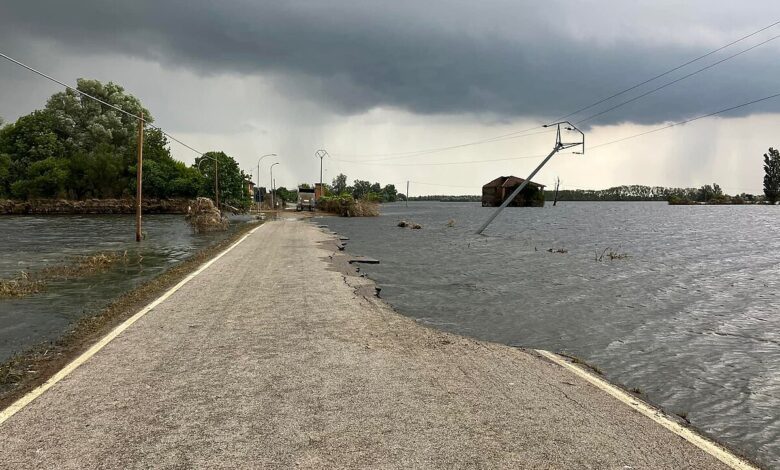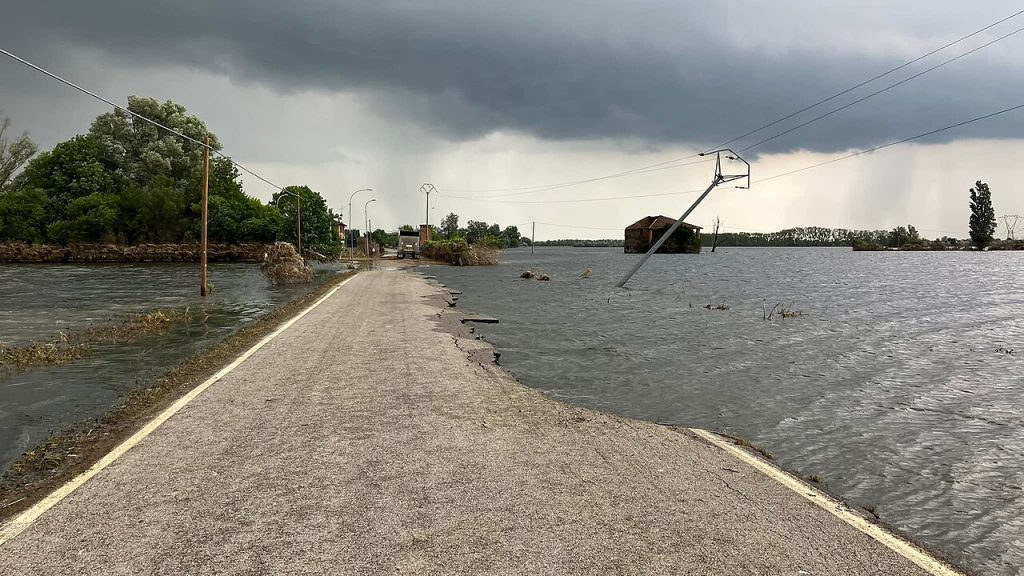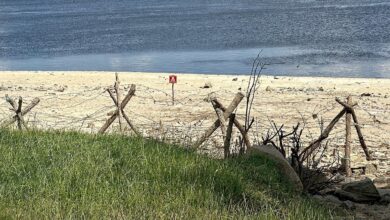
[ad_1]
Boretto, province of Reggio Emilia, northern Italy. Under the bridge at the entrance to the town, the river is almost invisible. The concrete foundations of its pillars, usually submerged, stand out. Where once flowed Italy’s longest river, the Po, there is now a large beach. Where once was a riverbed, boys and girls now venture on foot. A couple walks with a dog, throwing sticks into the distance. The animal races to retrieve them, happy to explore a territory normally off limits.
It’s April 2023. Not a single raindrop has fallen for two-and-a-half months. The river’s flow has dropped dramatically, raising fears of a repeat of what happened in 2022, when the Po reached its lowest flow in recorded history. ‘The river is at an extremely low level for the season,’ confirms engineer Alessio Picarelli from the Interregional Agency for the Po River (Aipo).
The agency, headquartered in Boretto, carries out hydrographic surveys. The meatori – the workers responsible for controlling the depth of the river – set out from here and the seven other stations every day. The agency then issues a bulletin to report on navigability conditions. It is a privileged observer of the so-called magre: the periods in which the Po suffers.
The lack of rain, combined with the absence of snow in the mountain ranges, is putting Italy’s greatest river under great strain. The snow does not fall at the same rate anymore and the Alpine glaciers, reservoirs of fossil water, are growing smaller. If on top of that it doesn’t rain, the whole system goes into crisis. This is a situation that will probably grow more and more frequent in the near future.
‘These flows are normally recorded in August’, says Picarelli. ‘But with an additional fact: in the summer, water is used for agriculture.’ In other words, when farmers pump water for irrigation, the problem will be even greater. ‘For years, predictive climate models have been telling us about the possibility of the Po Valley drying up. This is happening before our eyes. This is the trend. But, of course, the current situation could change at any moment.’
And indeed it did. In mid-May 2023, an unusual quantity of rain fell on various parts of the Po Valley, causing several rivers and streams to overflow. The Po ultimately remained within its banks, but many of its tributaries overflowed, with catastrophic impacts and a grave human toll: 16 people dead and 23,000 displaced.

Flooding in Emilia Romagna in 2023. Image: Nick.mon; source: Wikimedia Commons
A lack of vision
The Po is a litmus test for the increasingly marked effects of the climate crisis in Italy. At the centre of the Mediterranean area, the country is a climate hotspot, where the consequences of global warming are most pronounced. Rising temperatures, together with a succession of extreme weather events, are stressing the area.
According to the European Severe Weather Database, Italy experienced 3192 extreme weather events in 2022; some 2766 have already been registered in the first nine months of 2023. This is an astronomical rate, considering that the number rarely exceeded 100 between 2000 and 2010.
‘In Italy and throughout the Mediterranean, global climate warming has a special effect: not only is the average temperature rising, the extremes are also increasing because the circulation of the atmosphere is changing,’ explains atmospheric physicist Antonello Pasini. ‘Before, we were used to the high atmospheric pressure that always came from west to east, mainly with the famous Azores anticyclone. This anticyclone was a buffer of stable air, and protected us from the weather disturbances in Northern Europe, as well as from the African heat. Now anthropogenic global warming has caused the tropical equatorial circulation to expand northward. This change means African anticyclones, previously permanently present in the Sahara desert, are entering the Mediterranean and reaching Italy. When they eventually move back, cold currents enter and meet with the previous warm and humid air, creating an enormous thermal contrast. And this is how extreme weather events happen.’
Fluctuation between alarmingly low water levels and catastrophic floods seems to be the new trend on the Po, as on several other Italian rivers. The 2022 drought was the worst in 200 years, causing agricultural yields and hydroelectric production to plummet. According to Italy’s largest agricultural association Coldiretti, water shortages caused a 10 percent drop in Italy’s agricultural production, with farmers estimated to have lost approximately six billion euros. This year has been little better, with the succession of droughts and extreme events causing enormous damage on a similar scale.
‘We should call things by their name: we are in the midst of a climate emergency.’ Born and raised in the area, Giuliano Landini is the living memory of the river. He is the captain of the Stradivari, Italy’s longest inland cruise ship. At the helm of his vessel, anchored in the port of Boretto, he is disconsolate. He looks at the river and shakes his head.
For years the captain has been complaining of a lack of vision for Italy’s largest river. ‘The current climate scenario clearly shows us the weakness of the system. Either we weep because the Po is dry, or we live in fear of floods. The fact is that the river has been abandoned to itself. I always ask myself: why does the Seine, the Danube, the Elbe – all the great European rivers – remain navigable while the Po suffers?”
For Landini, the solution is clear: bacinizzazione, or basinisation. This plan would consist of dams with hydroelectric power plants and navigation locks. ‘This would allow the river to always be navigable and would avoid wasting water when there is plenty of it. As a man of the river, like my father and grandfather, I can assure you that we will not come out of this until we manage the water once and for all through dams on the Po.’
A previous campaign in the area called for five dams. Only one has been built, on Isola Serafini in the Piacenza province, with a basin and a hydroelectric power station. The other plans have been shelved. And it was decided to keep the river flowing freely.
Basinisation is not a solution shared by everyone – least of all environmentalists, who fear too radical a change in ecosystems. But one part of Landini’s argument is indisputable: the Po is a forgotten territory. What was once a vibrant place, with its own culture and economy, is now on the margins, ignored by politicians and even by those who live along its banks.
Overused and undervalued
‘No one likes to talk about the Po’, continues Landini. ‘Yet its water is useful for everyone: for agriculture, industry, energy production and more.’ It is the giant Italian paradox. A third of the country’s inhabitants live in the Pianura Padana, the Po Valley. It generates 40 per cent of the national GDP, 35 percent of agricultural production, and 55 percent of hydroelectric production. Yet the Po is treated as an obstacle not as a resource. Or even worse: as a reservoir from which to draw water for the valley’s many factory farms, to take gravel, or to use as a sewer for industrial wastewater.
‘The area has been over-exploited. It is no secret that it is the most polluted region in Europe’, says Paolo Pileri, professor of Territorial and Environmental Planning at the Polytechnic of Milan. He explains that the flooding in Emilia-Romagna last May had such disastrous effects because the territory had been made fragile by human action. ‘Between 2020 and 2021, Emilia-Romagna is the region with the third highest rate of land consumption in Italy. Some 658 hectares were concreted over in just one year, equal to 10.4 percent of the national total. In just a few years the water resistant surface in the region has reached 8.9 percent, compared to a national average of 7.1 per cent. We know perfectly well that water does not filter through asphalt but instead flows quickly off it, accumulating in quantity and energy, and causing damage and victims.’
It is almost as though the Po and its tributaries, made invisible by human exploitation, are taking back the space that was stolen from them. ‘The Po is like a wounded giant. It swells and dries up at will. It becomes mean with water when agriculture is most thirsty. And it dispenses hardship and afflictions to those inhabitants who have turned their backs on him,’ Landini says poetically.
Faced with these erratic river trends, the numerous stakeholders who use the Po’s water are trying to envision solutions. ‘Data from recent years shows that drought is becoming a structural problem. The challenges of climate change impose a new reality in which we cannot blame an irrational use of the resource’, says Francesco Vincenzi, an agricultural entrepreneur and president of the National Association of Land and Irrigation Water Management. Agricultural organisations are active in proposing solutions for what to them is a vital problem. ‘To deal with the growing water shortage, it is necessary to launch an infrastructure plan to adapt irrigation channels and the safety of the water resource,’ adds Vincenzi.
The National Recovery and Resilience Plan, the funding instrument approved by the European Union after the Covid-19 pandemic, allocates 880 million euros precisely for the purpose of making the irrigation system more efficient and building containment basins. ‘These mini-reservoirs will allow water to be conserved in a multi-functional perspective, both for agriculture and for energy. Considering that today we retain just 11 percent of water, it is urgent to carry out these works.’
Everyone seems to agree on the need to retain a resource that is becoming scarcer every day. “But it’s also necessary to question the agricultural model that is dominant in the Po Valley,’ adds Pileri. ‘Farmers complain about an ecosystem that has become unbalanced, but it is these same farmers who have partly made it so. To give an example: in the central part of the Po, there are enormous expanses of corn, a crop that requires a lot of water. This corn is not used for human consumption, but to feed pigs on intensive farms and to make biogas. Does it make sense to use water to produce feed and energy instead of products for human consumption?’
According to Pileri, the only solution is to rethink the development model: that would mean stopping land consumption, changing production paradigms, and rethinking our relationship with ecosystems. But his reasoning does not attract much support. Despite the repeated disasters and the extensive damage to people and property, the fight against the climate crisis is not at the top of the Meloni government’s agenda.
Italy is one of the few European countries that does not have a national plan for adaptation to climate change. A draft plan has been lying around at the Ministry of the Environment since 2017, awaiting an evaluation that has never come. Some members of the governing coalition have repeatedly said that global warming is an overestimated problem.
The approach towards the Po Valley echoes that of the Italian government towards the climate emergency as a whole. Until the next drought or catastrophic event, when indifference will temporarily give way to counting the costs and bewailing an ‘inevitable’ and ‘unpredictable’ misfortune.
Source link




